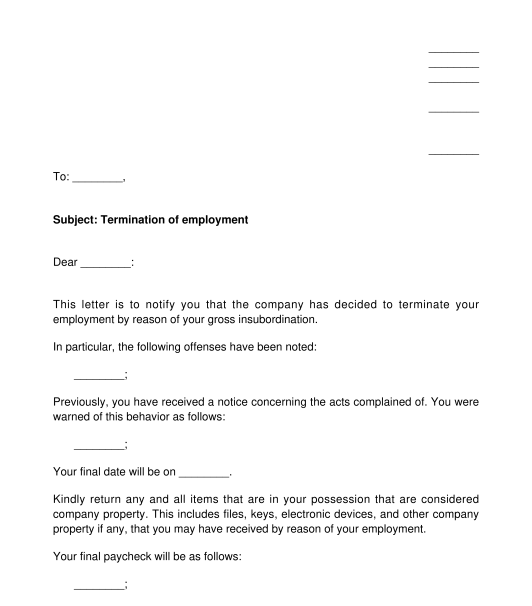 09/30/2025
09/30/2025

Answer a few questions and your document is created automatically.

Your document is ready! You will receive it in Word and PDF formats. You will be able to modify it.

 09/30/2025
09/30/2025
 Word and PDF
Word and PDF
 1 page
1 page
An Employment Termination Letter is a document that is given by the employer to the employee informing him of the fact of his dismissal or termination of his employment. This document shows the decision to dismiss such employee and the reasons for the same.
Other details that the former employee should know are the information concerning the last paycheck to be given and the separation benefits if any. Termination may either be caused by an act or offense on the part of the employee, or by reason of a management prerogative on the part of the employer. There are two general reasons for the termination or dismissal of an employee, it may be due to Just Causes or Authorized Causes. It must be noted that if the reason for the dismissal or termination originates from the employee, it is a just cause, while if it originates from the employer, it is an authorized cause.
Just Causes
If the employment termination is due to the acts of the employee, this may mean that the employee has committed a particular act that caused damage to the employer or is considered by the employer as a valid ground for employment termination. This is most commonly known as a just cause for employment termination. For instance, if an employee takes company property without consent or against the will of the employer, this is a just cause or a valid ground for employment termination.
The following are the just causes for employment termination:
Authorized Causes
If the termination is by reason of an exercise of a management prerogative on the part of the employer, this may mean that the employer is experiencing some financial burden which left him no other choice but to let go of the employee such as in the case of retrenchment or business closure. Other reasons for laying off employees may be redundancy, such as when the position of the employee is no longer giving benefit to the employer, or implementation of labor-saving devices which make the position of the employee unnecessary. There are also cases where the employee needs to be terminated because of health reasons, such as when the health condition of the employee renders him incapable of performing his duties. These are also called authorized causes for employment termination.
The authorized causes for employment termination are further defined below:
Giving the employee a Termination Letter is giving him due process by informing him of the facts surrounding his termination, and the duties and responsibilities of both the employer and the employee after the fact of termination.
The Employment Termination Letter shows the decision of the employer in dismissing the employee, the grievances of the employer against the former employee, and the specific reasons or grounds for the termination. The details concerning the employer should be included, the name of the employee terminated, and the signatory of the letter which usually comes from the human resource department of the employer.
The details of this letter may depend on the type of termination, if it is caused by the acts of the employee, the narration of how the employee committed the act which is considered a just cause or a valid ground for termination, must be included.
In case the termination is considered as a layoff or if there is an authorized cause for termination such as retrenchment, redundancy, business closure, and other similar causes, the details surrounding the same may be included.
The following details may also be included in this letter:
After completing the letter, it must be signed by the person who will send it, and a copy must be kept after sending it to the employee terminated.
The Labor Code of the Philippines is the law that governs employment termination in the Philippines. The Department of Labor and Employment also issues Department Orders to implement the laws found in the Labor Code and sets the daily minimum wage rates.
The general rules on contracts and obligations found in the Civil Code of the Philippines also apply.
You fill out a form. The document is created before your eyes as you respond to the questions.
At the end, you receive it in Word and PDF formats. You can modify it and reuse it.
Guides to help you
Employment Termination Letter - sample template
Country: Philippines